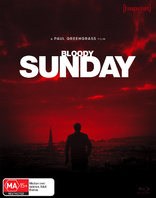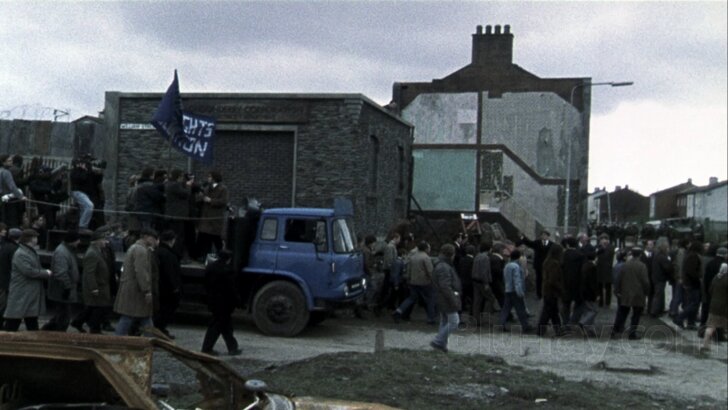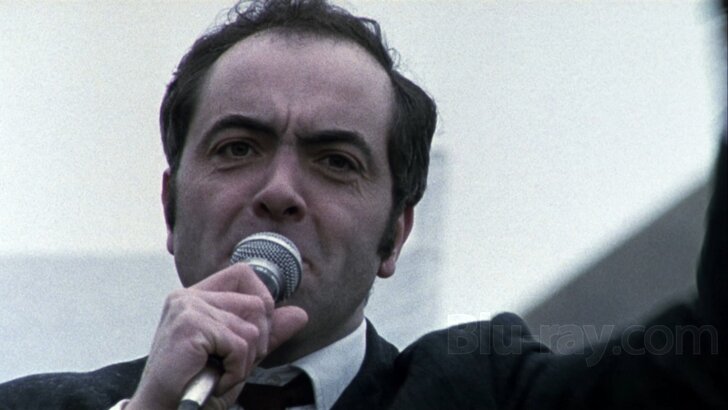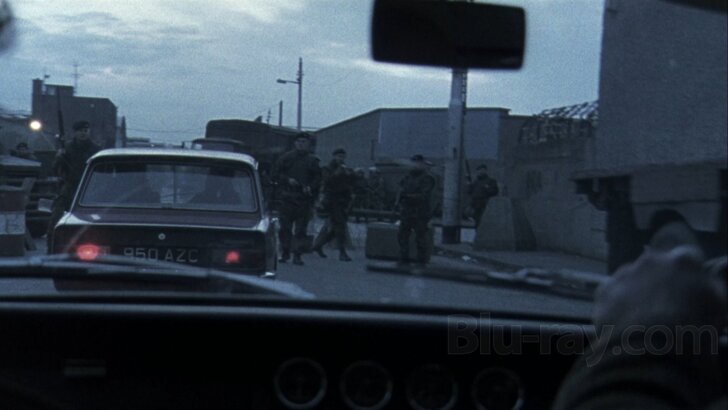Bloody Sunday Blu-ray Movie 
Imprint #131Imprint | 2002 | 1 Movie, 2 Cuts | 111 min | Rated ACB: MA15+ | May 25, 2022

Movie rating
|
| 7.5 | / 10 |
Blu-ray rating
| Users | 0.0 | |
| Reviewer | 3.5 | |
| Overall | 3.5 |
Overview click to collapse contents
Bloody Sunday (2002)
A dramatization of the Irish civil-rights protest march and subsequent massacre by British troops on January 30, 1972.
Starring: James Nesbitt, Tim Pigott-Smith, Nicholas Farrell, Gerard McSorley, Christopher VilliersDirector: Paul Greengrass
| War | Uncertain |
| Drama | Uncertain |
| History | Uncertain |
Specifications click to expand contents
Video
Video codec: MPEG-4 AVC
Video resolution: 1080p
Aspect ratio: 1.78:1
Original aspect ratio: 1.85:1
Audio
English: DTS-HD Master Audio 5.1
English: DTS-HD Master Audio 5.1
Subtitles
English SDH
Discs
Blu-ray Disc
Single disc (1 BD)
Playback
Region free
Review click to expand contents
Rating summary
| Movie | 3.0 | |
| Video | 4.0 | |
| Audio | 5.0 | |
| Extras | 4.0 | |
| Overall | 3.5 |
Bloody Sunday Blu-ray Movie Review
Reviewed by Dr. Svet Atanasov October 2, 2022Paul Greengrass' "Bloody Sunday" (2002) arrives on Blu-ray courtesy of Via Vision Entertainment. The supplemental features on the release include audio commentary by Paul Greengrass and actor James Nesbitt; documentary on the making of the film; various archival featurettes and interviews; and more. In English, with optional English SDH subtitles for the main feature. Region-Free.

The one thing that Paul Greengrass’ Bloody Sunday gets one hundred percent right is that January 30, 1972, was an incomprehensibly tragic day. But everyone with a basic understanding of The Troubles already knew this. Bloody Sunday should have been an authoritative examination of the rest, which is everything from the events preceding the massacre to the intricate politics that made it possible. Sadly, Bloody Sunday only pretends to be that kind of illuminating film.
Immediately after the opening credits disappear, the viewer is placed right in the middle of a hectic publicity circus. In Derry, civil rights activist and prominent member of the parliament Ivan Cooper (James Nesbitt) and local community leaders have a press event and confirm their intent to march for peace. Because many people are expected to join them there are very particular security concerns, but Cooper assures everyone that proper preparations have been made. Elsewhere in Derry, the commander of the British army paratroops that have been deployed in the area has a short press event, too. He states that order in the city will be maintained, even if he must use force.
During and after the press events there is enormous static in the air and both sides feel its presence. But they ignore it. Then, in the hours before the march, they repeatedly insinuate that if something were to go wrong, the other side would be held responsible.
As agreed, Cooper leads the march but after its preapproved path is altered the large crowd splits. Tensions rise, young hooligans become unruly, and eventually, the British soldiers are given green light to restore order. This is the beginning of the massacre that would become known as Bloody Sunday.
Greengrass shot all of the material that ended in Bloody Sunday with a very shaky, hand-held camera and then edited it in a very particular fashion to make the complete film emulate a documentary. Some of the mayhem looks like it was extracted from a documentary, but Bloody Sunday never tricks the mind to accept that it may not be a very carefully staged production. (For reference, this is precisely what Gillo Pontecorvo’s The Battle of Algiers accomplishes and why it remains such a powerful film -- nothing in it appears staged).
What disappoints the most, however, is Greengrass’ refusal to put a range of very relevant aspects of the drama under the microscope so that Bloody Sunday earns the trust of the skeptic. For example, was there indisputable evidence that the I.R.A. did not have provocateurs in the crowds? (According to The New York Times, Gerald Donaghey, who was killed during Bloody Sunday, was a member of the youth wing of the I.R.A. and was found in possession of nail bombs, though apparently he wasn't trying to use them. Link to article here). At the end, Cooper states precisely what the skeptic would have immediately pondered, which is that the massacre destroyed the progress that had been made and the IRA welcomed hundreds of thousands of new members. Also, Greengrass never entertains the idea that the massacre was a tragic byproduct of a massive political failure as well. In one of the archival programs that are included on this release, there is a veiled admission that it was so. Why? Because there were already very particular developments in the parliament that would have delivered many and in time likely all the results Cooper and his associates pursued. So, if Cooper had credible information that the British were seeking a very particular and tragic outcome, and Greengrass shows that he did, why didn’t he consider the bigger picture and use his status as a prominent politician to avoid what was undoubtedly on the horizon?
Similar important questions about crucial failures on the other side are untouched as well. For example, was an official decision made in London, by top members of the British government, to initiate the massacre, or did a single high-ranking military official greenlight it? How exactly did the troops on the ground misjudge the situation? Initially, Greengrass reveals them working on a very specific plan to control the march and avoid violence, but later they are filmed simply as a bunch of blood-thirsty dogs shooting at anything they perceive to be a proper target. The leadership failure is staggering, but on what level? The inability to consider the big picture is maddening, but on what level again? If politicians in London did not foresee the potential for a massive disaster, it is astonishing. If a single high-ranking military official in Derry initiated the massacre, then this is another equally infuriating political gaffe because he should have never been placed in a position to do so.
Greengrass’ version of the massacre is very disturbing, but it does not look or feel sufficiently illuminating. It is appropriately tense and channels anger that is extremely easy to understand, but it is a tiny piece of something very big that needs to be carefully reexamined and brought to the screen with much greater authority.
Bloody Sunday Blu-ray Movie, Video Quality 

Presented in an aspect ratio of 1.78:1, encoded with MPEG-4 AVC and granted a 1080p transfer, Bloody Sunday arrives on Blu-ray courtesy of Via Vision Entertainment.
It is incredibly difficult and perhaps impossible to accurately judge the technical presentation of Bloody Sunday. This release is obviously sourced from an older master, but the film is shot in a way that pretty much invalidates the usual standards we apply to judge the quality of a presentation. Indeed, the film's pseudo-documentary appearance manipulates delineation, clarity, depth, shadow nuances, highlights, and even color balance, so it is very difficult to guess what the ideal appearance of the film in 1080p should be like. Still, even though grain exposure is clearly manipulated as well, I could tell that it should be a little healthier. However, there are areas where its exposure is identical to what you would see with a shaky encode, and there are areas where I actually think that the encode should be more convincing. Some highlights should be better balanced, but it is hard to tell exactly by how much. I noticed a couple of tiny nicks. Image stability is good, but the shaky camera produces plenty of material that is again incredibly difficult to judge. All in all, if Bloody Sunday is fully remastered in the future, I think that it would have a superior appearance. However, there is a lot of very particular, very unusual stylization in it that will largely retain the roughness of the visuals as they are on the current master. (Note: This is a Region-Free Blu-ray release. Therefore, you will be able to play it on your player regardless of your geographical location).
Bloody Sunday Blu-ray Movie, Audio Quality 

There are two audio tracks on this Blu-ray release: English DTS-HD Master Audio 5.1 used for the UK theatrical version of the film and English DTS-HD Master Audio 5.1 used for the U.S. theatrical version of the film. Optional English SDH subtitles are provided for the main feature.
I viewed the film with the U.S. theatrical audio and still felt the need to turn on the optional subtitles. However, was not simply because the accents were too thick. In some areas, there are pretty substantial fluctuations because the intent was to create a documentary environment, which means that plenty of the exchanges overlap. During the mass footage, the audio design again welcomes a lot of very diverse organic sounds and noises, so it is not always easy to hear everything that is said. I did not encounter any transfer-specific anomalies to report in our review.
Bloody Sunday Blu-ray Movie, Special Features and Extras 

- Theatrical Trailer - presented here is an original U.S. trailer for Bloody Sunday. In English, not subtitled. (2 min).
- "Ivan and Jimmy" - in this archival program, politician Ivan Cooper and James Nesbitt visit the location where the infamous march started and the former discusses the socio-political environment at the time. There are some very interesting comments about the history of the conflict in North Ireland as well. In English, not subtitled. (4 min).
- On Location - presented here is footage from the shooting of Bloody Sunday on location in Londonderry. In English, not subtitled. (5 min).
- Interview Featurette - this archival program takes a closer look at the production of Bloody Sunday as well as the depiction of the tragic events that are chronicled in it. Included in it are clips from interviews with James Nesbitt, Paul Greengrass, Ivan Cooper, Jim Sheridan, Mary Moulds, Allan Gildea, and Mike Edwards, amongst others. In English, not subtitled. (23 min).
- "Q&A at the Curzon Cinema" - in this archival program, Paul Greengrass and James Nesbitt discuss their involvement with Bloody Sunday. Included in the program is footage from Simon Berthon's The H-Block Fuse (1980). In English, not subtitled. (15 min).
- Interview with Ivan Cooper, Paul Greengrass, James Nesbitt, and Producer Mark Redhead - in this archival program, Ivan Cooper, Paul Greengrass, James Nesbitt, and Mark Redhead explain how Bloody Sunday came to exist and discuss its production as well as the particular story they wanted to tell with it. In English, not subtitled. (54 min).
- "Bloody Sunday: History Retold" - presented here is raw footage from the shooting of Bloody Sunday in Londonderry with comments from Paul Greengrass and cast and crew members about the history of the tragic event that inspired it. In English, not subtitled. (14 min).
- "Bloody Sunday: Ivan Cooper Remembers" - in this archival featurette, Ivan Cooper and James Nesbitt visit some of the locations where the march on Bloody Sunday passed through. In English, not subtitled. (8 min).
- Commentary One - this audio commentary was recorded by Paul Greengrass and James Nesbitt.
- Commentary Two - this audio commentary was recorded by co-producer Don Mullan.
Bloody Sunday Blu-ray Movie, Overall Score and Recommendation 

The greatest accomplishment of Paul Greengrass' Bloody Sunday is that it managed to unite people from Londonderry and former British paratroopers that were permanently scarred by The Troubles. But I have to be honest and write that I expected it to be a very different, much more authoritative film. While Bloody Sunday does make it easy to sample the chaos and horror of the massacre, in the end, it leaves the impression that there is a lot more that is part of something big that needs to be carefully reexamined and brought to the screen with far greater authority. Via Vision Entertainment's presentation of Bloody Sunday is good and there is a fine selection of archival bonus features to go along with it. (If the subject matter of Bloody Sunday appeals to you, also consider Tony Luraschi's The Outsider and Yann Demange's '71).

















